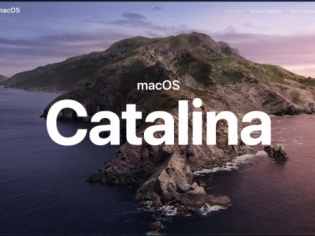-
Team TechTree
08:19 11th Oct, 2019
Apple MacOS Catalina Changes the Way One Uses Apps | TechTree.com
Apple MacOS Catalina Changes the Way One Uses Apps
The journey of connecting the iPhone with the iPad and the MacBook continues with the Catalina operating system

Having used the MacBook for nearly two decades, each time Apple has upgraded its operating system, the typical reaction has been at best a muted one and at worst has been ignored completely. The reasons are obvious – Apple has stuck to making changes that are subtle and gradual, allowing users to get familiar with major changes that gets built over time.
There is hardly any excitement when the updates happen to the MacOS as compared to those in the iOS versions, the latest of which came in about ten days ago. However, the latest in the series – Catalina - released earlier this week, has made users sit up and take notice. For, the new OS has made more pronounced changes, especially in the way one uses the many Apps.
The new OS, which can be downloaded from here, has found immediate favor though there are a few things one needs to keep in mind before actually starting to use it. A report published on the Time Magazine’s online edition suggests caution because “apart from the typical headaches plaguing users attempting to install OS upgrade, Catalina fundamentally changes what apps one can (or can’t) use on the Mac once the new software is ensconced in it. But, more of that later.
Brian Heater writing in TechCrunch says, “While it’s true that the underlying principles are the same, there are some fundamental changes to day-to-day applications that both impact current use and lay the groundwork for future evolutions of the desktop operating system.”
The first change one notices upon install is the absence of the iTunes. Critics may argue that 18 years is quite a long time for a software to disappear but the fact remains that the music app is an integral part of every Apple user’s routine. Of course, the app continues to live on in Apple Music but the new OS has shifted users over its much-hyped premium content section.
Simultaneously, one would notice the upgraded TV app which sets the stage for Arcade and TV+ as well as Podcasts that now boasts of its own desktop app. Of course, Apple is not forcing anyone to use these but the signs are clear enough. Sooner than later, the company would be banking on growing revenues from its premium content section.
Continuing with Apple’s decision to blur the lines between the Mac and the iPads, the Catalina OS gives pride of place to Catalyst that allows iPad apps to play on the MacBook. Apple’s News, Voice Memos, Stocks and Home apps would be getting ported over to the desktops in the none too distant future to continue to the synergy between the two major hardware components.
Of course, there are those who believe that the Catalina does allow the Mac to stand separately from the iPad and co-exist. However, this is where the new OS seems to be setting the trend once again for the future. The most interesting feature in the release is the Sidecar, though one may have to wait longer to figure out what exactly it is meant to achieve for the company.
In the past, there were several apps that allowed users to turn their iPads into additional monitors for the Mac but with Catalina OS the developers have ensured against the need for an external app. The Sidecar which turns the tablet into a second screen for the laptop. One just needs to go to Display in Settings on the Mac and tick the box to show it on the menu bar. The rest is easy!
The dual screen desktop could enthuse users who want to multitask while on the move, but what was really exciting is the manner designers can use the Apple Pencil with the iPad while connected to the desktop or laptop via Sidecar. The feature turned the tablet into a drawing tablet on apps that already support the stylus input such as Photoshop and Illustrator. Talk about ease of operation!
There are some more upgrades that pop up as one starts using the new operating system. These aren’t earth-shattering but definitely something that users could do with. Some of them are listed here:
- Privacy Changes seems to be on the priority list and Apple it has done some decent work to make Catalina tough for attackers to break into. It has introduced Sign in with Apple just as it did with the iPad OS in order to protect email IDs from the apps one uses.
- Voice Control is another area that the company has worked upon to allow specially-abled users to gain better control of the gadget. Now the Mac can almost totally be controlled by voice commands, including it completely into the operating system.
- Screen Time has been quite a popular feature on the iPhone and the iPad and now figures prominently on the Mac in Catalina. It allows users to tie up all the screen time one uses across gadgets and come up with a solid number.
- Other apps that have got significant downloads include Notes and Reminders (just as it did on the iOS 13), the Find My gadget feature, QuickTime, which gets a picture-in-picture feature and Mail where Apple allows users to block senders, mute threads and unsubscribe to newsletters.
Overall, the Catalina is something worth downloading though one may prefer to wait a bit as some of the apps that run on 32-bit may just stop functioning. This user got a bit of a shock as post update, the McAfee app refused to fire up! But, more of that in another post at another time.
For now, the Catalina is carrying forward Apple’s journey of synergizing its products and tying them up closer to each other than ever before.
TAGS: Apple, MacOS, Catalina, iOS 13, Catalyst, Arcade, Sidecar
- DRIFE Begins Operations in Namma Bengaluru
- Sevenaire launches ‘NEPTUNE’ – 24W Portable Speaker with RGB LED Lights
- Inbase launches ‘Urban Q1 Pro’ TWS Earbuds with Smart Touch control in India
- Airtel announces Rs 6000 cashback on purchase of smartphones from leading brands
- 78% of Indians are saving to spend during the festive season and 72% will splurge on gadgets & electronics
- 5 Tips For Buying A TV This Festive Season
- Facebook launches its largest creator education program in India
- 5 educational tech toys for young and aspiring engineers
- Mid-range smartphones emerge as customer favourites this festive season, reveals Amazon survey
- COLORFUL Launches Onebot M24A1 AIO PC for Professionals







TECHTREE